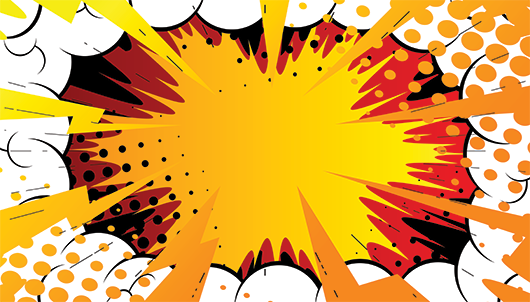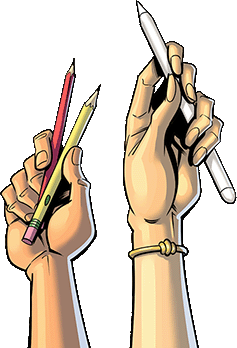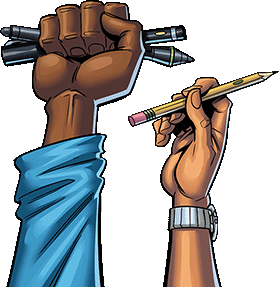Here's a Checklist of the Specifications Your Comic Printer Will Need
March 13, 2021
If you’re on your way to printing your very first comic book, there’s a laundry list of things you need to check. A professional team of printing experts is invaluable in this process, as they will ask you for specifications about your comic book, which you should have on hand.
Here is a checklist of everything you need to know before your printing team contacts you. Understanding industry standards like page size and paper weight will help you make critical decisions, so your finished comic book will exceed all expectations.
Before you head to the printers, you should have these issues decided. That way, the printing process will be quick and effortless.
Type of Binding
You can use two main types of binding for your comic book or graphic novel – perfect-bound and saddle-stitched. The type of binding you want depends mainly on the page count.
With saddle-stitched comic books, two pages are printed onto one large sheet and then stapled down the middle with wire staples. You have to submit a manuscript with a page count that’s divisible by four. These are easy to print, and the printer can distribute the physical copies widely.
Perfectly bound books are ideal for longer texts, typically graphic novels, with more than 60 pages. If your comic or graphic novel is over 260 pages, some printers can make a custom binding for you for such a large tome.
Perfect bindings have straight spines on which to display the name of the comic book. The pages are glued into a cardboard spine, making a perfectly bound book pricier and more durable than its saddle-stitched counterparts.
Paper Characteristics
What the paper feels like between your fingers depends on whether you opt for untreated, glossy, or another type of paper. Generally, people use uncoated pages for their comic book’s interior and heavier-weight paper for the cover.
You can laminate the cover of your graphic novel with UV-resistant material that keeps your comic in better condition for longer. If you would like to save money on your publication, you can use the same type of paper for the outside cover as you do for the inner pages, called a self-cover. These won’t last as long as a laminated version.
Paper Weight
The standard comic industry paper weight is around 80 lbs., although most stock paper is 55 to 65 lbs. The added thickness in your paper allows for more color saturation and less bleed-through.
Your printing specialist can guide you in many of these decisions, but before you get to that stage, you should know if you want a thicker-feeling paper or the industry standard.
Paper Dimensions
Not only do you have to determine what weight paper you would like, but you should also specify what dimensions your comic book should be. The industry standard size for comics is 6⅝” wide and 10¼” tall.
You don’t have to stick with this standard by any means, but make sure you choose dimensions well-suited to bookshelves or backpacks. If you make a comic book with outlandish proportions, it may be too unwieldy to sit on the shelf, and so it won’t be displayed as often.
Black-and-White vs. Full Color
Specific cells and panels look fantastic in full color like spreads or wide landscape shots. Most opt for full color for the cover, so it pops since it’s the first thing that potential readers see.
To save on costs, you should opt for everything but the most spectacular art to be in black and white. Using a mix of full color and black-and-white panels reduces your overhead while at the same time creating extraordinary contrasts in your creation.
There’s a border around the edges of a page, called the bleed, which the printer trims down in the printing process. Make sure that all the vital information is contained inside a .125” within the page. If you want the look of a full bleed artwork, which goes all the way to the edge of the paper, make sure to extend the images to the very edges, so you don’t get any unsightly gaps after printing.
Number of Books
How many books you want to be printed in a single run will make a difference in your printing project’s final price. There are two types of printing – offset and digital. Depending on how many books you want to print, you can choose the appropriate printing process.
If you’re only printing a few hundred copies of your comic, opt for digital printing as the excessive setup used in offset printing can be costly. However, if you plan to print upwards of 750 copies, an offset printing process can provide high quality without the cost. (If the quantity of books is higher, the price is spread out among more books, so it’s lowered for each book.)

The Last Word
With the right tools and the right team of printing specialists behind you, like Comix Well Spring, you will have an experienced hand guiding you throughout the creative process to publication.
Learning more about industry standards and the reasoning behind them can help you make the right decisions for your graphic novel or comic book.
All comic series, from Dark Horse Comics to DC Comic, have to make these critical decisions. If you want to be in the comics industry, you should know the reasoning behind these choices.
Our professional staff and experience can give you peace of mind in your publishing journey anywhere in North America. Please contact the professionals at Comix Well Spring today to begin the process.


